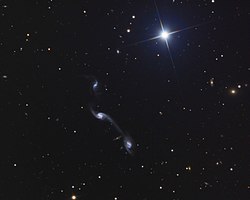Arp248 - HST - Potw2244a
Credit:
ESA/Hubble & NASA, Dark Energy Survey/DOE/FNAL/DECam/CTIO/NOIRLab/NSF/AURA, J. DalcantonThis image from the NASA/ESA Hubble Space Telescope shows two of the galaxies in the galactic triplet Arp 248 — also known as Wild's Triplet — which lies around 200 million light-years from Earth in the constellation Virgo. The two large spiral galaxies visible in this image — which flank a smaller, unrelated background spiral galaxy — seem to be connected by a luminous bridge. This elongated stream of stars and interstellar dust is known as a tidal tail, and it was formed by the mutual gravitational attraction of the two foreground galaxies.
This observation comes from a project which delves into two rogues’ galleries of weird and wonderful galaxies: A Catalogue Of Southern Peculiar Galaxies And Associations, compiled by astronomers Halton Arp and Barry Madore, and the Atlas of Peculiar Galaxies, compiled by Halton Arp. Each collection contains a menagerie of spectacularly peculiar galaxies, including interacting galaxies such as Arp 248, as well as one- or three-armed spiral galaxies, galaxies with shell-like structures, and a variety of other space oddities.
Hubble used its Advanced Camera for Surveys to scour this menagerie of eccentric galaxies in search of promising candidates for future observations with the NASA/ESA/CSA James Webb Space Telescope, the Atacama Large Millimeter/submillimeter Array, and Hubble itself. With such a wealth of astronomical objects to study in the night sky, projects such as this, which guide future observations, are a valuable investment of observing time. As well as the scientific merits of observing these weird and wonderful galaxies, they were also — very unusually — selected as Hubble targets because of their visual appeal to the general public!
[Image description: Two spiral galaxies are viewed almost face-on; they are a mix of pale blue and yellow in colour, crossed by strands of dark red dust. They lie in the upper-left and lower-right corners. A long, faint streak of pale blue joins them, extending from an arm of one galaxy and crossing the field diagonally. A small spiral galaxy, orange in colour, is visible edge-on, left of the lower galaxy.]
Credit:
ESA/Hubble & NASA, Dark Energy Survey/DOE/FNAL/DECam/CTIO/NOIRLab/NSF/AURA, J. Dalcanton
Coordinates Position (RA): 11 46 40.80 Position (Dec): -3° 51' 9.14" Field of view: 3.02 x 3.34 arcminutes Orientation: North is 33.3° right of vertical
Colours & filters Band Wavelength Telescope Optical G 474 nm Víctor M. Blanco 4-meter Telescope DECam Optical R 644 nm Víctor M. Blanco 4-meter Telescope DECam Optical Z 919 nm Víctor M. Blanco 4-meter Telescope DECam Optical V 606 nm Hubble Space Telescope ACS.
| ESA/Hubble images, videos and web texts are released by the ESA under the Creative Commons Attribution 4.0 International license and may on a non-exclusive basis be reproduced without fee provided they are clearly and visibly credited. Detailed conditions are below; see the ESA copyright statement for full information. For images created by NASA or on the hubblesite.org website, or for ESA/Hubble images on the esahubble.org site before 2009, use the {{PD-Hubble}} tag.
Conditions:
Notes:
|
- Dieses Werk darf von dir
- verbreitet werden – vervielfältigt, verbreitet und öffentlich zugänglich gemacht werden
- neu zusammengestellt werden – abgewandelt und bearbeitet werden
- Zu den folgenden Bedingungen:
- Namensnennung – Du musst angemessene Urheber- und Rechteangaben machen, einen Link zur Lizenz beifügen und angeben, ob Änderungen vorgenommen wurden. Diese Angaben dürfen in jeder angemessenen Art und Weise gemacht werden, allerdings nicht so, dass der Eindruck entsteht, der Lizenzgeber unterstütze gerade dich oder deine Nutzung besonders.
Relevante Bilder
Relevante Artikel
Arp 248Arp 248, auch als Wilds Triplett bezeichnet, ist ein interagierendes Galaxientriplett im Sternbild Jungfrau auf der Ekliptik. Sie ist schätzungsweise 230 Mio. Lichtjahre von der Milchstraße entfernt. Halton Arp gliederte seinen Katalog ungewöhnlicher Galaxien nach rein morphologischen Kriterien in Gruppen. Diese Galaxie gehört zu der Klasse Galaxien mit Anzeichen für eine Aufspaltung. .. weiterlesen


